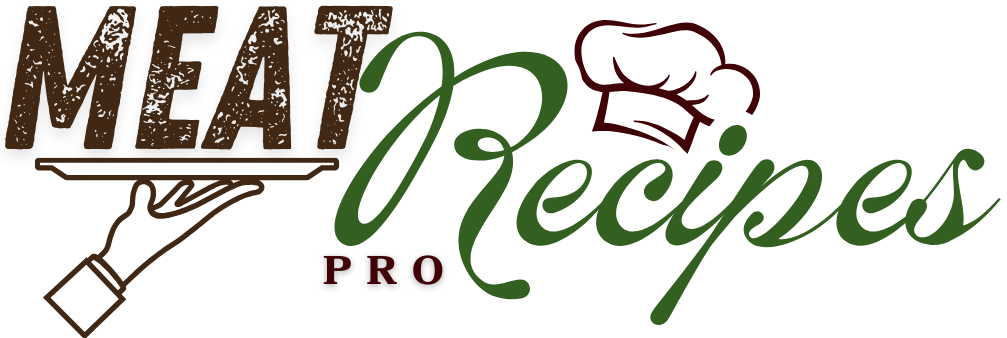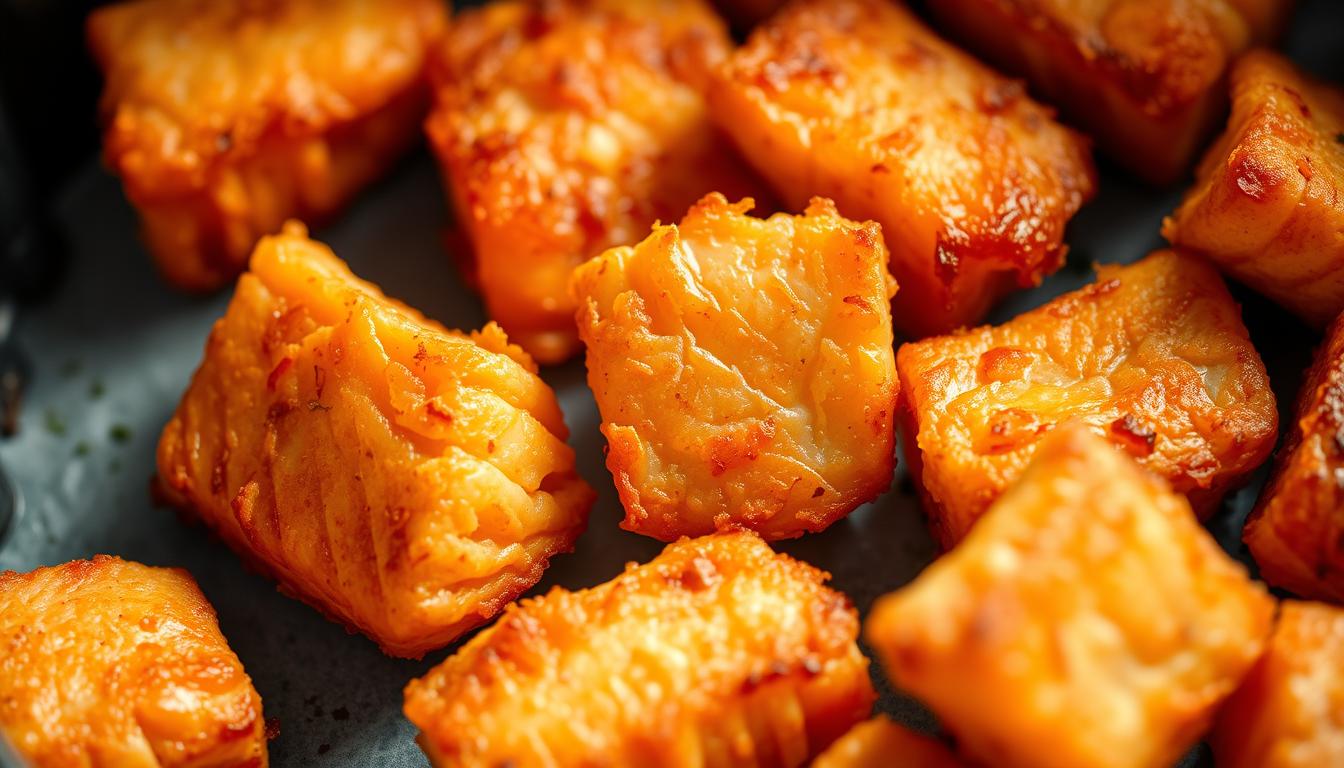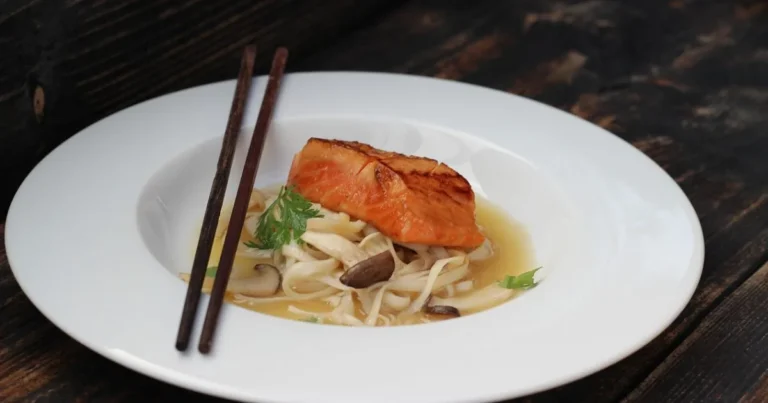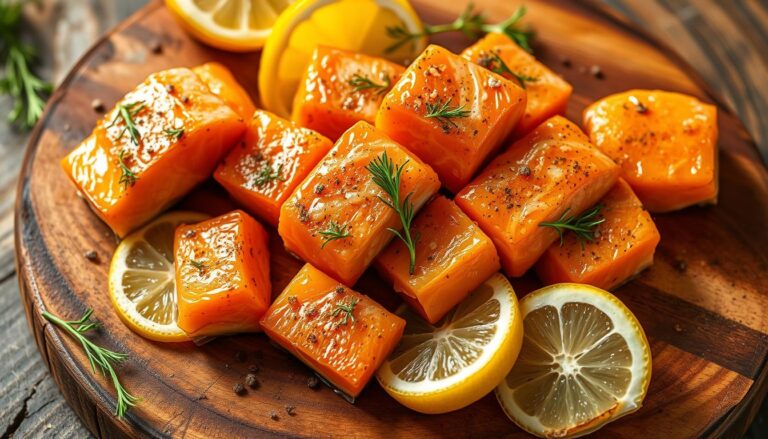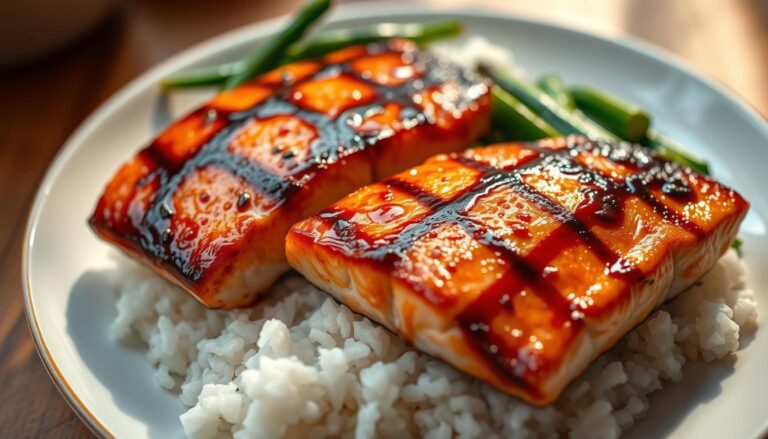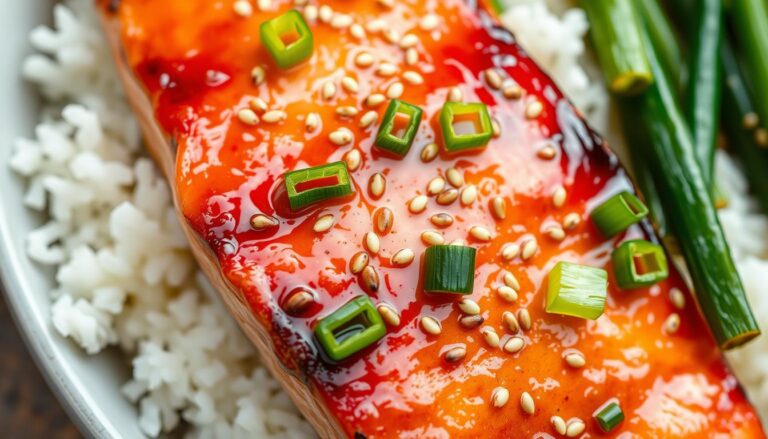Perfectly Crispy Salmon Bites Made in Air Fryer
ou know that small rush when a fast weeknight meal turns out better than takeout. You want food that feels special but fits your schedule. This short recipe delivers a crispy exterior and tender center in just minutes. It gives you a reliable dinner that feels homemade and confident.
Here’s what matters: preheat and lightly oil the basket, cook at 400°F for 5–7 minutes, and shake halfway so pieces brown evenly. Aim for 145°F internal to keep the fish juicy and safe. Use a blackened rub or a soy-honey-garlic-ginger marinade for bold flavor, and finish with a squeeze of lemon for brightness.
This easy recipe also covers thawing frozen fillets, smart storage for leftovers, and quick reheating so your protein stays flaky and ready. Stick with these steps and you’ll have consistent, restaurant-style results every time.
Table of Contents
What You’ll Learn About Making Air Fryer Salmon Bites Today
With clear times, temps, and seasoning options, you’ll master a weeknight protein that cooks fast and tastes bold.
Quick facts: Cut fish into 1-inch cubes and cook for 5–7 minutes at 390–400°F. Shake the basket halfway and aim for 145°F internal to keep the protein tender.
Choose a blackened or Cajun rub for spice, or a soy-honey-garlic-ginger glaze that caramelizes. Serve over rice, in salads, tacos, or bowls. Preheat and lightly spray the basket to prevent sticking.
- Timing and temp for consistent golden results.
- Flavor paths: spice rubs vs. savory-sweet marinades.
- Storage: refrigerate up to 3 days; reheat at 350°F for about 3 minutes.
| Step | Temp | Time |
|---|---|---|
| Cook 1-inch cubes | 390–400°F | 5–7 minutes (shake halfway) |
| Reheat leftovers | 350°F | ~3 minutes |
| Doneness target | 145°F internal temperature | |
Ingredients You’ll Need for Salmon Bites
Start simple. Gather skinless, deboned salmon filets and cut them into even 1-inch pieces so each cube cooks the same. Pat the fish dry before seasoning; this helps edges crisp and spices adhere.
Salmon cubes, oil, and pantry spices
Dry blend: mix sweet paprika, cayenne, garlic powder, dried thyme, dried oregano, kosher salt, and black pepper. A light spritz of olive oil helps the mix cling and promotes browning.
Optional sweet-savory marinade
Whisk low-sodium soy sauce (or coconut aminos), honey, rice vinegar, toasted sesame oil, grated garlic, and fresh ginger for a glossy glaze. Use low-sodium options to control salt as the sauce concentrates while cooking.
Garnishes and sauces
Finish with sesame seeds, sliced green onions, and lemon wedges. Add a drizzle of sriracha aioli or spicy mayo for creaminess. Keep jasmine or basmati rice warm as a base that soaks up extra sauce.
| Item | Purpose | Note |
|---|---|---|
| Salmon filets | Main protein | Skinless, deboned, 1-inch cubes |
| Olive oil | Helps brown | Spritz lightly |
| Garlic & honey | Marinade flavor | Fresh grated works best |
Step-by-Step: salmon bites in air fryer
Follow these clear steps to turn raw fillets into crisp, flavorful cubes that finish fast and clean.
Prep the filets
Remove skin and any pin bones, then pat the pieces dry. Cut into even 1-inch cubes so each piece cooks at the same rate and browns uniformly.
Season or marinate
Blackened rub: toss cubes with sweet paprika, cayenne, garlic powder, dried thyme, oregano, salt, and pepper for bold, smoky heat.
Marinade: whisk low-sodium soy or coconut aminos, honey, rice vinegar, sesame oil, grated garlic, and fresh ginger. Marinate at least 10 minutes for a caramelized glaze.
Air fry setup
Preheat your unit to 390–400°F and lightly spray the air fryer basket with olive oil to reduce sticking and boost browning.
Arrange the pieces so you place salmon with space between each cube. Use a single layer so hot air circulates freely and edges crisp.
Cook and shake
Air fry for 5–7 minutes, shaking or flipping at the halfway mark to expose new surfaces. If you marinated, brush a little leftover sauce at the flip for extra shine.
Check doneness with a quick-read thermometer around 5 minutes; 145°F signals properly cooked fish. Let the pieces rest briefly so juices redistribute, then serve immediately for best texture.
- Tip: Keep batches small the first time you use a new fryer basket to dial in timing.
- Tip: Pull smaller cubes early to avoid overcooking larger ones.
Time, Temperature, and Doneness
Control time and heat, and you’ll get crisp exteriors with tender, flaky centers every time.
Best results: For 1-inch cubes, set your unit to 390–400°F and cook about 5–7 minutes. Shake the basket halfway to expose new surfaces and promote even browning.
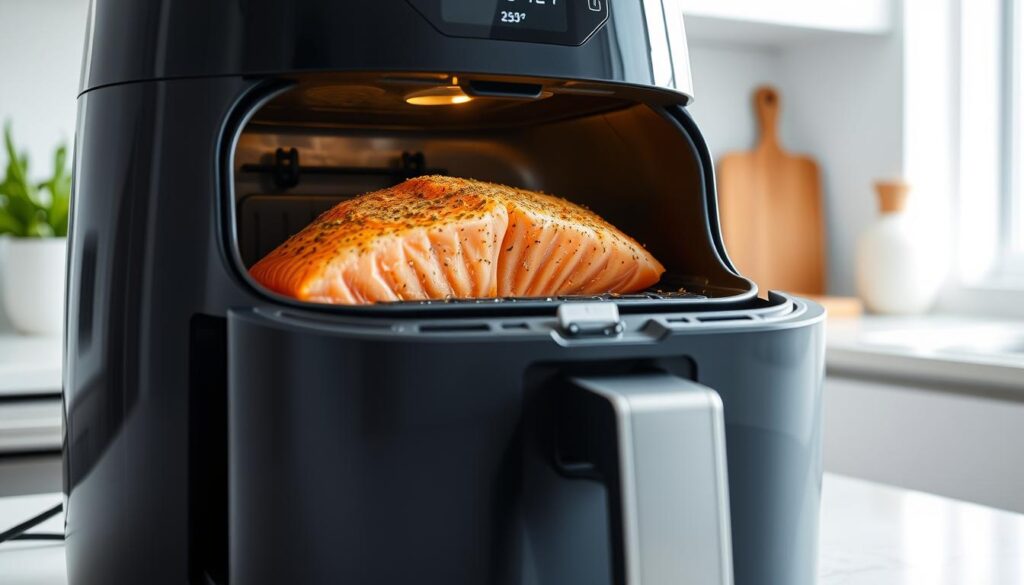
Always confirm doneness with a quick-read thermometer. Pull the fish at an internal reading of 145°F for safe, moist results. Start checking at the 5-minute mark because carryover heat will continue to cook the pieces briefly.
If your cubes are thicker or your model runs hot or cool, add just 1–2 extra minutes rather than a long stretch. Avoid overcrowding the basket—airflow is what crisps the outside fast.
- If you must speed-thaw frozen salmon, keep it sealed and submerge in cold water, changing the water every 30 minutes.
- Use a pepper-forward rub with care at 400°F; edges can darken quickly, so watch closely near the end.
- Note your exact time for repeatable results with your specific fryer and cube size.
Pro Tips to Get Crispy Outside and Tender Inside
A few simple tricks help you lock in moisture while building a golden, crunchy exterior.
Start by patting the fish dry. Remove surface moisture so the coating crisps instead of steaming. Cut equal-sized pieces so every cube cooks at the same rate.
Preheat and oil the basket and the food. A light spray of olive or avocado oil on both the basket and the pieces promotes even browning and prevents sticking.
Cook a single layer only. Leave small gaps between pieces so hot air can circulate. Overcrowding traps steam and softens the crust.
- Shake the basket halfway to expose new surfaces and get golden edges.
- If you use pepper-heavy seasoning, add pepper near the end to avoid burning.
- Thaw frozen fish overnight in the fridge or use a sealed-bag cold-water method, refreshing water to keep it chilled.
- If your fryer runs hot, lower temp by 10–15°F or shave off a minute to protect tenderness.
- Let the pieces rest 1 minute after cooking so juices settle, then serve promptly for best texture.
Flavor Variations and Seasoning Ideas
Experiment with rubs and glazes to match your meal—go smoky, sweet, savory, or bright with lemon and herbs.
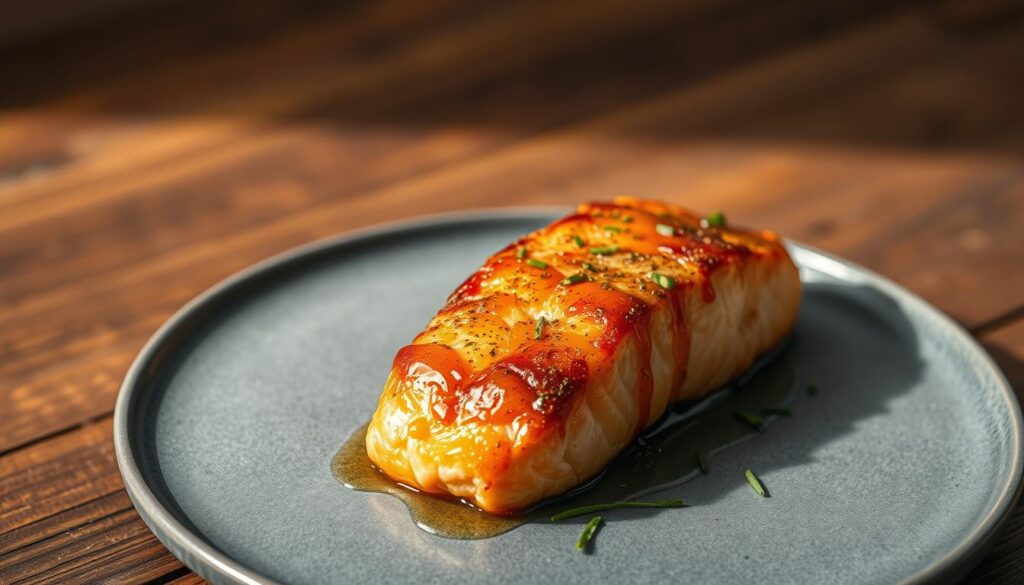
Blackened and Cajun: Go bold with a mix of sweet paprika, cayenne, garlic powder, dried thyme, oregano, salt, and black pepper. This blend builds a smoky, spicy crust that holds up well on quick cooks.
Savory-sweet glaze
Mix low-sodium soy or coconut aminos with honey, grated garlic, and fresh ginger. Add sesame oil and a pinch of red pepper flakes. Brush lightly near the end so the glaze caramelizes into a glossy coating.
Teriyaki twist
Use coconut aminos for a gluten-free option. Stir in sesame oil and fresh aromatics. Garnish with sesame seeds and scallions and serve over coconut rice for a balanced plate.
Lighter lemon-herb
Toss pieces with a lemon-pepper or simple garlic-herb blend for a bright, fresh profile. Finish with a squeeze of lemon and a sprinkle of chili crunch if you want texture.
- Quick sauces: sriracha aioli, citrus tartar, or a yogurt drizzle complement these flavors without weighing them down.
- When trying other air fryer recipes, swap these blends onto shrimp or white fish for fast weeknight hits.
Serving Ideas: Bowls, Rice, Salads, and More
A single batch serves many meal styles—build bowls, toss into greens, or pile into tortillas.
Bowls: Layer warm jasmine, basmati, or coconut rice with hot salmon bites, sliced cucumber, avocado, and halved tomatoes. Add a punchy sauce and a sprinkle of sesame seeds for contrast.
Salads: Toss warm pieces over mixed greens for an easy protein boost. Vinaigrettes and creamy dressings both pair well with the rich fish. Keep dressings on the side if you plan leftovers.
Make taco night
Wrap the pieces in corn tortillas and top with cabbage slaw and a tangy yogurt-based sauce. The crunch from the slaw balances the tender center and adds bright texture for dinner.
Veggie sides
Round out the plate with simple sides: air fryer asparagus, garlicky green beans, or roasted broccoli. These cook quickly and keep cleanup low.
| Meal | Main starch | Topping ideas |
|---|---|---|
| Bowl | Jasmine / Basmati / Coconut rice | Cucumber, avocado, tomatoes, sesame |
| Salad | Greens | Vinaigrette or creamy dressing, lemon wedge |
| Tacos | Corn tortillas | Cabbage slaw, yogurt sauce, scallions |
- Vary bowls by swapping rice for quinoa or cauliflower rice and add edamame or pickled veg.
- Keep garnishes handy—lemon wedges, sesame seeds, and scallions brighten each bite.
- For next-day lunches pack sauce separately to keep textures crisp.
Equipment, Basket Styles, and Setup
The right unit makes a big difference when you want crisp results fast.
Choose equipment based on capacity and how you cook most often. Basket-style units, Instant Pot air fryer attachments, and toaster-style models all work for quick protein cooks. Smaller models need batch cooking; larger toaster-style units hold more but can have hot spots.
Basket vs toaster-style: capacity and airflow
Basket-style units force hot air around a single layer for even browning. They perform best when pieces have space and the basket is not crowded.
Toaster-style ovens often handle more volume and can use trays or racks. Rotate trays halfway to even out any hot spots and keep contact searing consistent.
Why preheating and oil-spraying the basket matters
Preheat to 390–400°F so the surface sears on contact. This creates immediate sizzle and better browning.
Lightly spray the basket with a neutral, high-heat-safe oil to reduce sticking and boost crisping. Keep the fryer basket clean; old residue can cause sticking and uneven heat.
- Cook single layers when possible; overcrowding traps steam and softens crusts.
- Use racks only if they don’t block airflow—an even layer gives the most consistent results.
- If your unit runs cool, raise the temp slightly or add one minute and monitor color and internal temp closely.
- Match the equipment to your routine—bigger units cut down on batches for busy weeknights.
Storage, Meal Prep, and Reheating
Keep a few cooked portions on hand and you’ll have a wholesome dinner ready in minutes.
Fridge storage: Refrigerate cooked salmon in an airtight container for up to 3 days to preserve flavor and texture. Label containers with the cook date and seasoning so you can rotate meals smartly.
Reheat: Use your air fryer at 350°F for about 3 minutes, shaking the basket halfway to restore crisp edges without overcooking the center. If you prefer the stove, warm on medium for 5–8 minutes and avoid crowding the pan so steam doesn’t soften the crust.
Meal prep tips: Cook batches in single layers using the air fryer basket or a fryer basket and cool quickly. Portion with rice and vegetables for ready-to-heat dinners. Always thaw frozen salmon before cooking; for a safe quick thaw, place the sealed fillet in cold water and change the water until pliable.
- Store sauces separately to prevent sogginess.
- Keep batch sizes consistent so reheating minutes are predictable and protein stays juicy.
- These fryer recipes and this simple prepping approach make weeknights easier and keep quality high.
Nutrition at a Glance: Protein and Healthy Fats
See how protein and healthy fats add up so you can balance your plate fast.
Typical serving: Roughly 1 cup of prepared cubes runs about 251–284 calories, with ~34–35g protein and ~11–12g fat. That protein level helps you stay full and supports muscle repair after workouts.
These pieces are rich in omega-3 fatty acids, which count as healthy fat and support heart and brain health. Keep sauces light to keep total fat moderate.
Sodium can rise quickly when you use soy-based marinades. Choose low-sodium sauces and watch added salt. Bright accents like lemon and cracked pepper boost flavor without extra sodium.
- Pair with rice, greens, or roasted vegetables to add fiber and carbs.
- Measure portions by cups or pieces to keep macros steady for meal prep.
- Cooking with hot air cuts oil needs, so texture stays crisp while fat stays controlled.
| Nutrient | Per 1 cup | Notes |
|---|---|---|
| Calories | 251–284 kcal | Varies by marinade and oil used |
| Protein | 34–35 g | High; supports satiety and muscle maintenance |
| Total fat | 11–12 g | Includes omega-3s; moderate when you limit added oil |
| Sodium | Variable | Watch soy-based sauces; choose low-sodium options |
Conclusion
Nail the basics—trim, dry, and time—so the final dish is fast, flaky, and flavorful.
Quick wrap: Start with skinless, deboned salmon filets and cut into even 1-inch cubes. Pat dry, season or marinate, then preheat to 390–400°F and lightly spray the basket before you place salmon in a single layer with space between pieces.
Air fry for 5–7 minutes, shaking once, and make sure the internal temp reaches 145°F so the fish is safe. Finish with a squeeze of lemon and a crack of pepper. Serve over rice or build a bowl with fresh veggies and a light sauce.
Cool quickly for meal prep, store up to 3 days, and reheat about 3 minutes at 350°F. Keep a little water nearby for cleaning and wipe the basket after each use to keep flavors bright.
